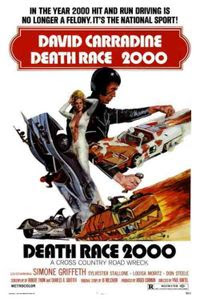
Roger Corman's second last film until he stopped directing, and the film that marked his break from AIP (though he did produce
Boxcar Bertha for them later) - after years of no interference, Corman claims that AIP cut the film around, changing the ending, and removing the voice of "God" from the film. While AIP owed Corman better, one can be sympathetic because this is a totally insane film - genuinely free-wheeling and anarchic, even more so than the films Corman made from scripts by Charles Griffith (George Armitage wrote this script).
It is set in a world where a gas has killed everyone over 25 (some links to AIP's earlier
Wild in the Streets (1968)). Robert Corff and Elaine Giftos play the leads, two young kids who meet in a confessional (he’s on the run from the cops after a prank and is pretending to be a priest; she is confessing having an affair with his professor). They like each other instantly and form a bond as they flee persecution from their fellow youngsters. They hook up with a black revolutionary (Ben Vereen), his 60s pop-mad girlfriend (Cindy Williams), a cowboy (Bud Cort) and a freak girl (Talia Coppola, later Talia Shire) and set off to find a pueblo in New Mexico where everyone is living together. That’s all the plot really, an excuse for various adventures – they run into various conservatives, most notably a bunch of football players but also some golf-loving bikies.
Although Corff and Giftos dig each other he winds up sleeping with a girl at a drive in concert a quite sexy psychedelic love scene, reminiscent of the one in
The Trip. Giftos doesn’t mind. For all the peace and love stuff, note how the hippies get their car back by using guns, and that they break up the interracial couple (Williams wants to hang out listening to rock music, enabling Vereen to run off with a black woman.)
Corman fans will see a lot of self parody - a character on a motorbike dressed as Vincent Price called "Edgar Allan Poe", references to Westerns and biker movies,
The Trip love scene.
The cast are enthusiastic (Corff and Griftos make a likeable pair of leads, Cindy Williams has a great monologue, there is a strong support cast) but the real star is the script - well, that's half correct: the script is frustrating and episodic, but just when you get sick of it they throw in a curve ball of some line of brilliance. The ending is unexpectedly uplifting - everyone coming together in a party (I'm not exactly sure why). Some of the highlights: a shoot out where the characters keep yelling out cowboy star names (Vereen yells out “Jim Brown” – because “he’s the only one” i.e. only black); Billy the Kid having a horse called “pretentious”; Country Joe and the Fish talking to God and God responding about a car in the parking lot having left its lights on; a footballer tries to inspire a crowd – after yelling “one more time” the crowd replies “one more time”); bikers talk in war metaphors on the golf course; some tangy dialogue: “was that a bomb?” “no it was more ironic than that”. It pokes fun of the military, Nixon, the JFK assassination, Westerns, early 60s rock, B movie Western stars, Edgar Allen Poe, football players.
On the downside, the stuff where football players practiced their rapes was a little off.; ditto the scene where Giftos offers herself up as a “rapee” – she ends up having sex with three men and apparently enjoy it. Also, the film feels abrupt in places – one moment the world is normal, then we hear the gas is coming – then the gas has hit and kids are already recreating fascism. There’s never any weeping for anyone’s parents, relatives or friends over 25 – it’s all a bit of a joke.
Stephanie Rothman and Charles Swartz worked on the film as production associates – which on this sort of movie was presumably everything.





















